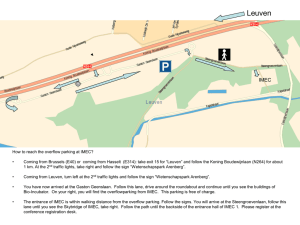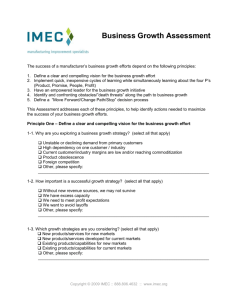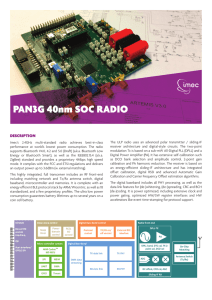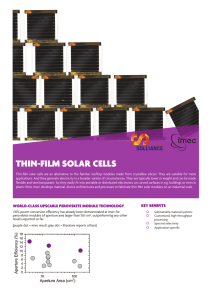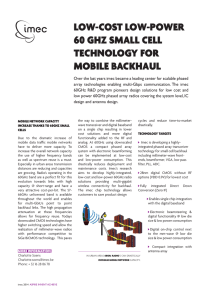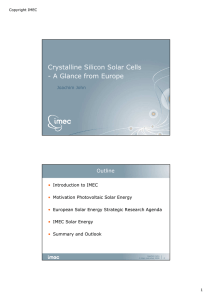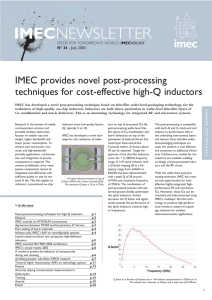Plan of approach
advertisement
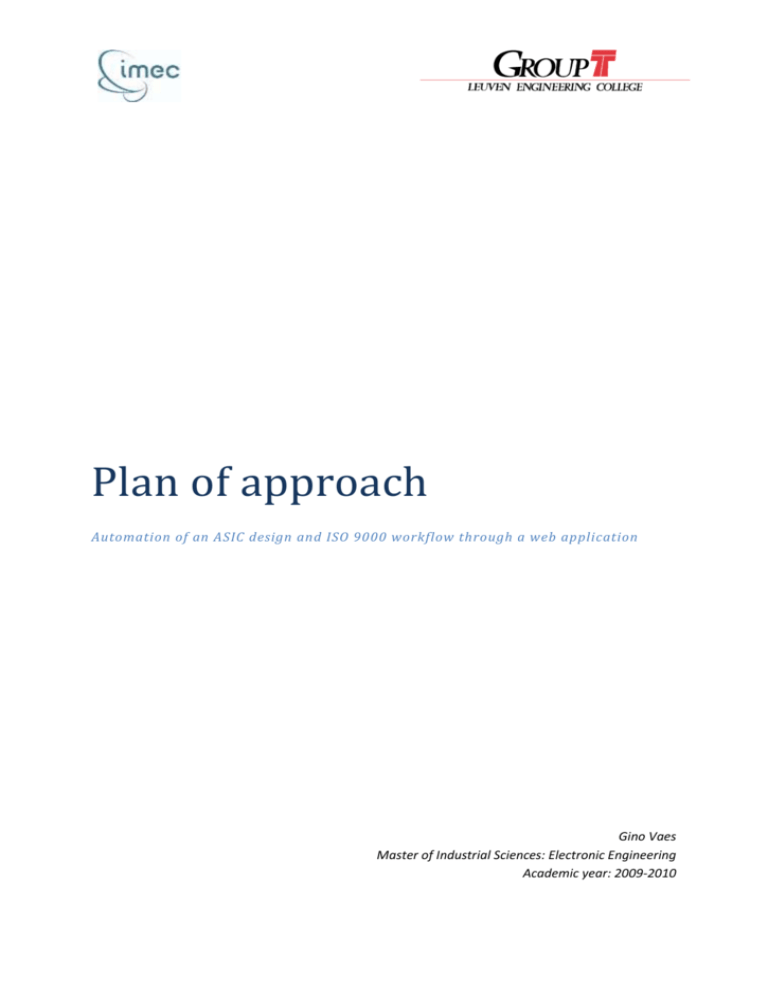
Plan of approach Automation of an ASIC design and ISO 9000 workflow through a web application Gino Vaes Master of Industrial Sciences: Electronic Engineering Academic year: 2009-2010 2 Table of contents 1. Introduction..................................................................................................................................... 4 1.1. Motivation ................................................................................................................................... 4 1.2. Approval and adaptation............................................................................................................. 4 1.3. Structure ...................................................................................................................................... 4 2. Project description .......................................................................................................................... 5 2.1. Client............................................................................................................................................ 5 2.2. Student ........................................................................................................................................ 5 2.3. Initial state and background ........................................................................................................ 5 2.4. Goals ............................................................................................................................................ 5 2.5. Description of project .................................................................................................................. 6 2.5.1. Introduction to the problem ........................................................................................... 6 2.5.2. Technologies used ........................................................................................................... 6 2.5.3. Work-flow ........................................................................................................................ 6 2.5.4. My work........................................................................................................................... 7 2.6. Problemen ................................................................................................................................... 8 2.7. Expected result ............................................................................................................................ 8 2.8. Boundary conditions ................................................................................................................... 8 3. Management aspect........................................................................................................................ 9 3.1. Time management ...................................................................................................................... 9 3.2. Quality management ................................................................................................................... 9 3.3. Information management ........................................................................................................... 9 4. Bibliography................................................................................................................................... 10 3 1. Introduction 1.1. Motivation I will write this plan of approach (POA) with concern to my master thesis. The thesis is a piece of work with a study load 20 study points. This means I need to put ca. 550h of work into it. To achieve the desired result, I need a proper planning which I will try to put out in this POA. 1.2. Approval and adaptation This POA will be handed in on October 30. My promotor, Mr Pelsmaekers will go through it. Based on his criticism, possible adaptations will take place. During the period of my thesis, I will try to frequently update and adjust the deadlines mentioned. 1.3. Structure This plan of approach is devided in three parts. The first part illustrates the goals of this plan of approach. In the second part is an introduction to the company and me as a student. In this part I will try to explain the goals and description of what is expected of me. Last, the management aspects are given with special regards to time, quality and information management. 4 2. Project description 2.1. Client The client for which I make my master’s thesis is Mr. Luc Laeveren, he is Senior Asic Design Support Engineer at the IMEC company in Heverlee. This thesis is made in cooperation with Group T engineering college in Leuven. 2.2. Student My name is Gino Vaes, I am currently following a master course at the Group T engineering college in Leuven. The focus of this course is electronics and ICT, notably internet computing. 2.3. Initial state and background IMEC is a company located in Heverlee (Leuven). It possesses the largest independent R&D institute in Europe. The turn-over in 2008 was over 260mio Euro. The activities of IMEC consist of: - Advanced nanoelectronics technology development (22 nm and below) Microsystems, advanced packaging and interconnection technology development New design methodology development for ultra low-power, wireless sensor networks and Multi-Mode MultiMedia applications Training and industrial support (IMEC v.z.w., 2009) The INVOMEC division of IMEC was started in 1983 as an initiative to for training and ASIC (application-specific integrated circuit) support. Late in the 80’s MPW (multi project wafer) was introduced in the United States to deliver low-cost prototyping to universities and colleges. INVOMEC started this service in Belgium in 1986 with the support of the European Commission. In 1995 the Europractice IC-service was founded inside INVOMEC. Europractice extends the prototyping service for the academic world and companies. It also delivers the possibility for small volume production of IC’s for companies. Later on, MPW was replaced by Cybershuttle technology, which is basically the same. The purpose of my thesis is to design a software solution for automation of the ASIC design and ISO 9000 work-flow. 2.4. Goals The definition of a master’s thesis: “a piece of work for conclusion of the master’s program. By doing so, the student shows an analytical capacity or an independent problem-solving aptitude on an academic level (, or a capacity for artistic creation). The delivered work reflects a general critical or research-minded attitude.” (Buijs, 2009) It is clear that by doing a thesis; I (as a master student) have to show my analytical and problem solving capacities by doing a project on a high enough level. 5 2.5. Description of project 2.5.1. Introduction to the problem First I will explain which technologies Europractice uses. Next I will tell which work-flow is used and finally I will reveal my solution for the problem. 2.5.2. Technologies used In order to make IC’s, you first have to ‘bake’ them on a wafer (silicon disc). The process of how to bake a chip is not very relevant to my thesis, which is why I won’t bother you with the technical details. What is important is the fact that it is very expensive to produce a wafer, but the cost lowers if you make multiple. For prototyping not much IC’s are needed, so this can be very expensive. Cybershuttle project reduce the cost of prototyping by placing multiple designs on a wafer instead of only one. Design 1 Design 2 Figure 1 Cybershuttle wafer This way, multiple wafer of the same type can be made for obtaining lower prices. 2.5.3. Work-flow Every company of institution that wants to produce a chip sends their design to IMEC. This can either be done by ftp, e-mail, or other media. The design is then stored by IMEC on a local server. Multiple design checks take place to ensure there are no errors in it. Next, the results of these checks are send back to the corresponding company. If mistakes or design errors are found, the company has to correct them and commit their new design. After some back and forth communication, a final design is obtained. This is ready for production. Multiple designs are bundled on a Cybershuttle, depending on how many the company needs. IMEC sends the Cybershuttle to a company who produces it and the final product is send to the primary customer. This workflow is monitored by ISO 9000 rules to guarantee the quality of end products and services. 6 2.5.4. My work Until now, employees error check the design of the chip by running a script on the server where it is stored. The first thing they have to do is find the correct DRC file for the design. A DRC file is a Design Rule Checking file. “Design Rule Checking or Check(s) (DRC) is the area of Electronic Design Automation that determines whether the physical layout of a particular chip layout satisfies a series of recommended parameters called Design Rules.” (Wikipedia, 2009) There are a lot of different files, each with its own properties. They select one file and copy it to a different directory where they can edit some parts of it. A program called Calibre (made by the Mentor Graphics company) performs the check. This program takes the design and the DRC file as input, and it generates an error log as output. See figure 2 for a better overview. The error log contains all the errors found. Linux server DRC file Design of chip (check parameters) Perform check (Calibre) Employee Remote login Figure 2 Design checks The process of error checking is done in a very unproductive way, because finding the files and copying them to various different folders is very time-consuming. A software program can easily do all these things in a very fast way. It is my task to write this kind of program, its task is to: Keep track of all the checks that are done; Make it easier for the employees to keep an overview of the projects; Simplify the work flow. I will write this program in a programming language called Perl, because the employees are used to command line interfaces. Perl is also a very effective language for editing text files and other file related work. The next problem is ISO procedures. IMEC uses them because they prove that the company has a good quality management. The down side is that every action done in the work flow has to be 7 written down on a form. This is very time consuming and very often done afterwards instead of during the workflow. If every project would be kept in a database, a website could keep track of the workflow and it would be easier to fill in the ISO documents. This website and the database will also be made by me. The goal is to develop a website which is user friendly. Communication with the database can be done by the Perl program on the fileserver at IMEC, but also via the web application. Look at the drawing for further explanation. Communication via Perl program Web server Database File server at IMEC ia tion v unica Comm program IMEC network Internet Perl User connected to IMEC network User that is not connected to IMEC network Figure 3 Overview 2.6. Problemen If a task can’t be finished before the deadline, it can be solved by either simplifying the task or rearranging the order of them. In case of a bigger problem, a solution can be obtained by consulting my promotor at Group T or my copromotor at IMEC. 2.7. Expected result If everything goes as planned, both programs will be working at the end of july. 2.8. Boundary conditions Perl and PHP are relatively new programming languages to me, I will need to learn how they both work, this could cost me a lot of time. 8 3. Management aspect 3.1. Time management At October 30, I will hand in a work breakdown structure (WBS) of my thesis. It shows all the different subtasks. With the information on this WBS, a Gantt chart will be made also by October 30. This Gantt chart will show the due dates of the different subtasks. To keep track of my work, I will keep a personal logbook where I will register the time I spend on every task. This logbook will be updated frequently. Often, meetings between me and my promotor or copromotor will take place. In this way, the progress of this thesis can be followed closely. If any problem occurs and the normal planning can’t be followed, the Gantt chart can be adjusted. 3.2. Quality management I will ask for feedback every time I finish a task from the Gantt chart. This way I hope to obtain an optimal solution. For programming the software, I will try to sequence different subtasks. This will be done by first analyzing everything and coding only at the end of the process. Figure 4 Software programming steps 3.3. Information management In times like this, communication is possible in various ways. A wiki is an easy way to keep a log of the tasks I’ve done. There is an online tool called Springnote that I will use for this. To keep a backup of all my important documents, I will use a tool called dropbox. It’s used synchronizing a local folder with an online folder. Group T also asked us to keep a blog on a socially relevant theme with issues related to my thesis. Wordpress will enable me to make this blog easily. Of course other means of communication like email, telephone, and others will be used. 9 4. Bibliography Buijs, J. (2009, 09 22). The master thesis. Leuven, Belgium. IMEC v.z.w. (2008, 11). http://www.imec-nl.nl. Retrieved 10 20, 2009, from http://www.imecnl.nl/imec_sites/objects/dac6cf4a26f93598d385fdd95f11a7f5/ic28_agenda.pdf IMEC v.z.w. (2009, 08 21). IMEC - TSMC Emerging Business Program (EBP). Heverlee, Vlaams-Brabant, Belgium. Pelsmaekers, K. (2008, September). Software development introduction. Leuven, Belgium. Wikipedia. (2009, 09 26). Design rule checking. Retrieved 10 25, 2009, from Wikipedia: http://en.wikipedia.org/wiki/Design_rule_checking 10
